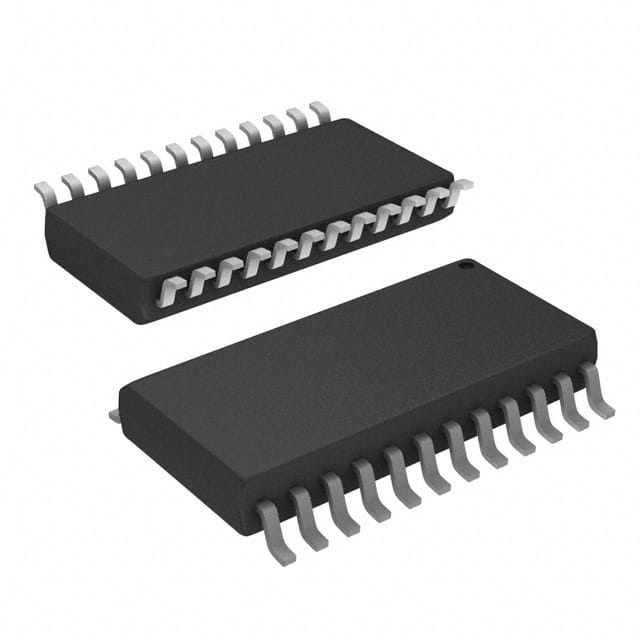Vedi le specifiche per i dettagli del prodotto.

PCF8575CDWR
Product Overview
- Category: Integrated Circuit (IC)
- Use: I/O Expander
- Characteristics: 16-bit remote I/O expander for I2C-bus with interrupt
- Package: SOIC (Small Outline Integrated Circuit) package
- Essence: The PCF8575CDWR is a versatile I/O expander that allows users to increase the number of input/output pins on a microcontroller or other devices using the I2C-bus protocol.
- Packaging/Quantity: Tape and reel, 2500 units per reel
Specifications
- Supply Voltage Range: 2.3V to 5.5V
- I2C-bus Interface: Compatible with I2C-bus Fast-mode and Standard-mode
- Number of I/O Pins: 16
- Interrupt Output: Active LOW open-drain interrupt output
- Input/Output Current: ±10mA
- Operating Temperature Range: -40°C to +85°C
Detailed Pin Configuration
The PCF8575CDWR has a total of 24 pins. The pin configuration is as follows:
- A0: Address input bit 0
- A1: Address input bit 1
- A2: Address input bit 2
- GND: Ground
- P0-P7: I/O Port 0-7
- INT: Interrupt output
- SDA: Serial data input/output
- SCL: Serial clock input
Functional Features
- Remote I/O Expansion: The PCF8575CDWR provides 16 additional I/O pins that can be controlled through the I2C-bus interface.
- Interrupt Functionality: The device features an interrupt output that can be used to notify the microcontroller when any of the I/O pins change state.
- Low Power Consumption: The PCF8575CDWR is designed to operate with low power consumption, making it suitable for battery-powered applications.
- Wide Operating Voltage Range: The device can be powered from 2.3V to 5.5V, allowing compatibility with a wide range of systems.
Advantages and Disadvantages
Advantages: - Easy I/O Expansion: The PCF8575CDWR simplifies the process of expanding the number of I/O pins on a microcontroller without the need for complex wiring. - Interrupt Capability: The interrupt functionality allows for efficient handling of I/O events, reducing the need for continuous polling. - Low Power Consumption: The device's low power consumption makes it suitable for energy-efficient applications.
Disadvantages: - Limited I/O Voltage Range: The PCF8575CDWR operates at the same voltage level as the VCC supply, which may limit its compatibility with devices that require different voltage levels. - I2C-bus Dependency: The device relies on the I2C-bus protocol for communication, which may introduce additional complexity in system design.
Working Principles
The PCF8575CDWR works by utilizing the I2C-bus protocol to communicate with the microcontroller or host device. It acts as an I/O expander by providing 16 additional bidirectional I/O pins. The device can be addressed using three address input pins (A0, A1, A2), allowing up to eight devices to be connected on the same bus.
When an I/O pin changes state, the PCF8575CDWR generates an interrupt signal on the INT pin, which can be used to trigger an interrupt routine in the microcontroller. This allows for efficient event-driven programming and reduces the need for continuous polling of the I/O pins.
Detailed Application Field Plans
The PCF8575CDWR finds applications in various fields, including:
- Industrial Automation: The device can be used to expand the number of I/O pins in industrial control systems, allowing for efficient monitoring and control of sensors, actuators, and other devices.
- Home Automation: It can be utilized in home automation systems to increase the number of available I/O pins for controlling lights, appliances, and security systems.
- Robotics: The PCF8575CDWR can be integrated into robotic systems to provide additional I/O capabilities for controlling motors, sensors, and communication interfaces.
- IoT (Internet of Things): The device is suitable for IoT applications where multiple sensors and actuators need to be connected to a microcontroller with limited I/O pins.
Detailed and Complete Alternative Models
- MCP23017: 16-bit I/O expander with I2C-bus interface and interrupt functionality.
- MAX7313: 16-bit I/O expander with serial interface and interrupt output.
- PCA9555: 16-bit I/O expander with I2C-bus interface and interrupt capability.
These alternative models offer similar functionality and can be considered as alternatives to the PCF857
10 domande e risposte comuni relative all'applicazione di PCF8575CDWR nelle soluzioni tecniche
Sure! Here are 10 common questions and answers related to the application of PCF8575CDWR in technical solutions:
Q: What is PCF8575CDWR? A: PCF8575CDWR is an I/O expander integrated circuit (IC) that provides additional input/output ports for microcontrollers or other digital devices.
Q: How many I/O ports does PCF8575CDWR provide? A: PCF8575CDWR provides a total of 16 I/O ports, which can be configured as either inputs or outputs.
Q: What is the voltage range supported by PCF8575CDWR? A: PCF8575CDWR supports a voltage range of 2.3V to 5.5V, making it compatible with a wide range of microcontrollers and digital devices.
Q: Can PCF8575CDWR handle both analog and digital signals? A: No, PCF8575CDWR is designed to handle only digital signals. It cannot process analog signals directly.
Q: How can I communicate with PCF8575CDWR? A: PCF8575CDWR uses the I2C communication protocol, allowing you to interface it with microcontrollers or other devices supporting I2C.
Q: Can I use multiple PCF8575CDWR ICs in the same project? A: Yes, you can connect multiple PCF8575CDWR ICs together on the same I2C bus, allowing you to expand the number of available I/O ports.
Q: What is the maximum current that PCF8575CDWR can sink/source per I/O pin? A: PCF8575CDWR can sink/source up to 25mA per I/O pin, making it suitable for driving LEDs, relays, and other low-power devices.
Q: Can PCF8575CDWR handle interrupts? A: Yes, PCF8575CDWR supports interrupt functionality, allowing you to trigger an interrupt on the microcontroller when a specific I/O pin changes its state.
Q: Is PCF8575CDWR compatible with 3.3V microcontrollers? A: Yes, PCF8575CDWR is compatible with both 3.3V and 5V microcontrollers, thanks to its wide voltage range support.
Q: What are some common applications of PCF8575CDWR? A: PCF8575CDWR is commonly used in applications requiring additional I/O ports, such as industrial automation, home automation, robotics, and sensor interfacing.
Please note that these answers are general and may vary depending on the specific implementation and requirements of your project.

